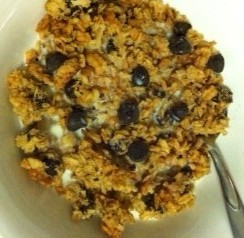
by EM2WL | Jun 20, 2013 | Breakfast, Recipes
 This chocolate chip baked oatmeal is definitely a family favorite. My guys despise oatmeal (goo, as they refer to it), but LOVE this granola bar-esque morning bowl of yum. It’s like a Quaker Chewy granola bar warm, and slightly crispy, served with milk. Of course, one could just attempt to pour milk over a Quaker Chewy…but that would so miss the point of indulging in this piece of chocolate chip heaven.
This chocolate chip baked oatmeal is definitely a family favorite. My guys despise oatmeal (goo, as they refer to it), but LOVE this granola bar-esque morning bowl of yum. It’s like a Quaker Chewy granola bar warm, and slightly crispy, served with milk. Of course, one could just attempt to pour milk over a Quaker Chewy…but that would so miss the point of indulging in this piece of chocolate chip heaven.
The original recipe used raisins which, of course, would still be an option…but doesn’t chocolate make everything better?
If you try it with raisins, let me know how it turns out. ~Kiki
Chocolate Chip Baked Oatmeal Recipe
|
Serves
| 12 |
|
Prep time
| 10 minutes |
|
Cook time
| 25 minutes |
|
Total time
| 35 minutes |
|
Allergy
|
Egg
|
|
Meal type
|
Breakfast
|
|
Misc
|
Freezable, Pre-preparable, Serve Hot
|
|
From magazine
|
Taste of Home
|
Baked oatmeal with chocolate chips and coconut. Baked until crispy (not gooey like traditional oatmeal), and served warm with milk.
Ingredients
- 2 Large eggs (or equivalent substitute)
- 1/2 cup coconut oil
- 1/3 cup packed brown sugar (I use Sucanat)
- 3 cups old-fashioned oats
- 3 teaspoons baking powder
- 1 teaspoon salt
- 3/4 teaspoons cinnamon
- 1/3 cup flaked coconut
- 2/3 cups chocolate chips (I use Hershey's Special Dark - raisins may be used instead)
Optional
- Milk (to serve with cereal)
Directions
|
|
| In a bowl, combine eggs, oil, and brown sugar. |
|
|
| In a separate bowl, combine oats, baking powder, salt, and cinnamon: add to egg mixture, stirring just until moistened. |
|
|
| Stir in coconut and chocolate chips (and/or raisins). |
|
|
| Spoon in to a greased 13x9 baking dish, pressing flat. Bake uncovered at 350 for 20-25 minutes or until edges are golden brown. |
|
|
| Immediately cut into 12 sections. Serve warm with milk, if desired. |
Note
This oatmeal will continue to harden as it sits, making it easy to store the leftovers, and perfect to add milk to soften back up later. Just be sure to cut into serving sizes while it is still warm, or this task becomes almost impossible, depending on how long you baked it.
Nutrition (for 1/12 of recipe, not including milk):
Calories: 256, Fat: 15g, Saturated: 9g (from coconut oil*), Cholesterol: 36g, Sodium: 244, Carb: 27g , Fiber: 3g, Sugar: 11g, Protein: 4g
The recipe provides a good source of Manganese (~40% of daily recommendations), 5% Calcium, and 7% Iron.
*Saturated Fat from coconut oil is not shown to hold the same health risks as saturated fats from animal fats (butter, meats, etc.), and is therefore considered a "good" fat. Be sure to look for "unrefined, cold-pressed" coconut oil, and if still concerned about using coconut oil, feel free to sub your fave oil.
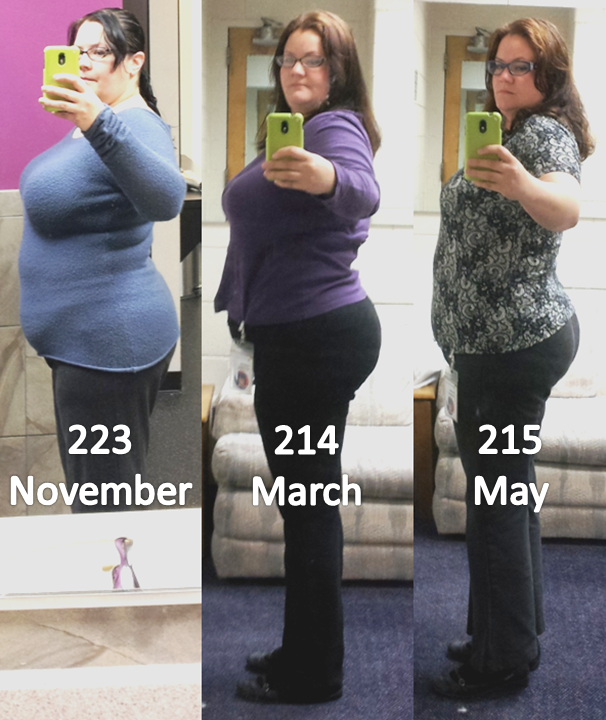
by EM2WL | Jun 17, 2013 | Motivation, Testimonials, The Journey, Tracking Progress
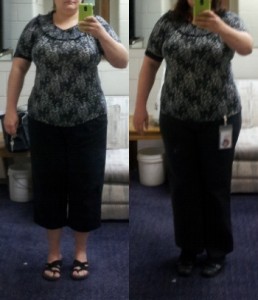
3 weeks progress – (recent on left)
I started out my weight loss journey eating a very low calorie diet and not doing much outside of my normal activity for exercise. While the pounds were dropping off at a great pace at that time my body started telling me something different. I started losing my hair, was exhausted constantly and even lost TOM (time of month). I knew something was wrong and started with a personal trainer and researching. Finding the EM2WL group helped immensely and my whole thought process around this has changed. It is no longer a weight loss journey, but a fat loss journey focusing on strength.
My weight has stabilized for now, but the inches are slowly going down. I gained a pound and lost an inch in my waist over the past few months. My smaller clothes are fitting better. My back is better. I had forgotten how strong I was when I was younger, but am now rediscovering my muscles.
I now have new goals in mind. My main goal is to be able to do a pull up and a dip unassisted by the end of the year.
Weight is not as much of a concern anymore. Yes, it is hard when I occasionally weigh in and don’t see progress, but that is when I just need to pull out my phone and look at all of the progress pictures to see that my hard work is paying off. Keep eating and your body will transform. I am constantly amazed at what my approaching 40 year old body can do.
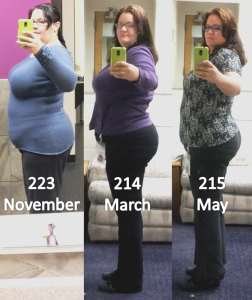
7 months progress – Only 8lbs lost! The scale does NOT tell the whole story!
Follow Sandi’s Journey here.
Share your success, no matter how large or small. You never know who you may inspire to hang on just a bit longer. We love featuring results and journey stories in REAL time, not just before/afters. If you have a victory (scale or not) let us know and allow us to share with the fam, by submitting to success@EM2WL.com

by EM2WL | Jun 7, 2013 | Cardio
Cardio Intensity: High, moderate, or low intensity cardio, which should you do? All have benefits, so picking the one (or better yet, including a mix) that will help you reach your goals is key.
-
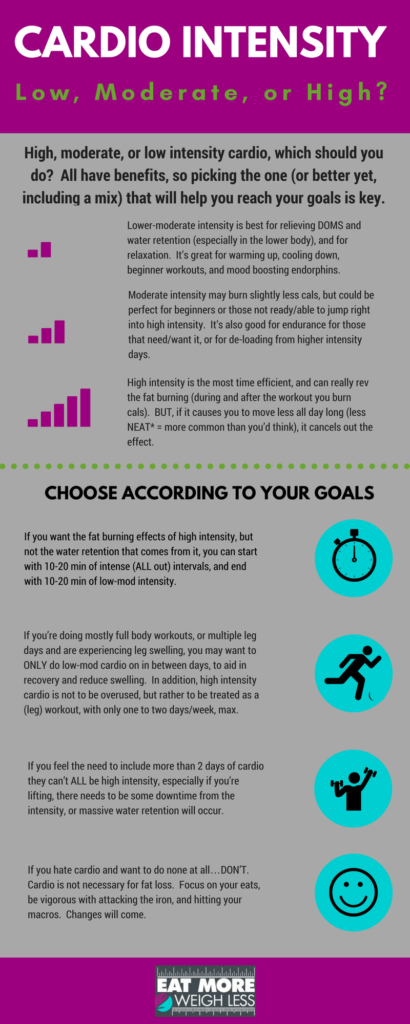
(Click Image to Enlarge)
High intensity is the most time efficient, and can really rev the fat burning (during and after the workout you burn cals). BUT, if it causes you to move less all day long (less NEAT* = more common than you’d think), it cancels out the effect. Common scenario: do a super intense workout, then flop in the closest chair and move less than you would’ve usually the rest of the day. Totally not getting the full advantage of that afterburn. Net effect: pointless, and no different than if you’d just done a lower intensity cardio, or even none at all. Due to the intensity of a perfectly executed HIIT session (similar to a strength workout), you will also tend to experience water retention/swelling. Some people allow this to bother them to the extent that they wonder if it’s worth it.
- Moderate intensity may burn slightly less cals, but could be perfect for beginners or those not ready/able to jump right into high intensity. It’s also good for endurance for those that need/want it, or for de-loading from higher intensity days. Depending on ones definition of “moderate” some swelling/retention may still occur.
- Lower-moderate intensity is best for relieving DOMS and water retention (especially in the lower body), and for relaxation. It’s great for warming up, cooling down, beginner workouts, and mood boosting endorphins.
So which method is best for you? Why choose? Sometimes people get so caught up in looking for the perfect method, that they miss the point. The variety/combo/goal application makes the changes happen. Having purpose is crucial. Mix and match according to your goals, limitations, and personal preferences. At any time, it’s perfectly fine to choose only one, or a combo. For instance:
- If you want the fat burning effects of high intensity, but not the water retention that comes from it, you can start with 10-20 min of intense (ALL out) intervals, and end with 10-20 min of low-mod intensity.
- If you’re doing mostly full body workouts, or multiple leg days and are experiencing leg swelling, you may want to ONLY do low-mod cardio on in between days, to aid in recovery and reduce swelling. In addition, high intensity cardio is not to be overused, but rather to be treated as a (leg) workout, with only one to two days/week, max.
- If you feel the need to include more than 2 days of cardio they can’t ALL be high intensity, especially if you’re lifting, there needs to be some downtime from the intensity, or massive water retention will occur.
- If you hate cardio and want to do none at all…DON’T. Cardio is not necessary for fat loss. Focus on your eats, be vigorous with attacking the iron, and hitting your macros. Changes will come.
Research for cardio is all over the place, and depending on the source it may heavily lean to one side or another. Having the “research bug” can cause us to self sabotage. I’m an avid researcher that has to force myself to ACT. We have to stop ourselves from always over analyzing everything. Sometimes knowledge is power…other times, it’s crippling. There is no, one, perfect way, so researching ourselves into a paralyzed stupor looking for it, is counterproductive.
Speaking from former, knowledge-paralyzed experience.
What about you? What type of cardio do you prefer? Have you found a mix that works best for you? Have you ever gotten so tied up in trying to find the “perfect” method of something that you ended up not doing anything at all?
~~~~~~~~~
*NEAT = Non-exercise activity thermogenesis. AKA what your FitBit (pedometer of choice) measures during “awake” hours. This is basically everything we do that is NOT sleeping, eating or exercise: walking around the house, going shopping, cleaning, fidgeting, etc…
by EM2WL | Jun 1, 2013 | Fat Loss / Cutting, Workouts
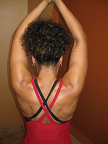 Torn between whether to lift heavy to build true, dense, muscle — or lighter weights for the temporary “pump” that it provides? You can have them both in this challenging workout.
Torn between whether to lift heavy to build true, dense, muscle — or lighter weights for the temporary “pump” that it provides? You can have them both in this challenging workout.
The Plan: A 4-day, workout split featuring a variation of push/pull with one heavy and one light day for each body part. The heavy days will truly challenge your muscles for growth (hypertrophy), while the lighter days will pull the much needed glycogen into the muscle (providing the “pump”). All sessions will work together spark your metabolism with maximum muscle recruitment. This workout uses dumbbells (or kettlebells) only, making it perfect for those with limited equipment. Working with dumbbells will allow for greater range of motion (deeper stretch and stronger contraction), recruit more stabilizer muscles (especially the core), as well as balance strength, muscular development and overall body symmetry. It is appropriate for reset, cut, or maintenance.
Weights: Begin with a 5-10 minute warmup on a cardio machine, and 1-2 warmup sets of each exercise (using lighter weight). Then proceed to select a weight that presents a slight struggle for the last few reps. Keep track of your weight selection, and increase weight whenever possible. If you can do 2-3 more reps than specified with your chosen weight, your weight is too light, and it is time to increase. You must push yourself for maximum results, even on “light” days (although you won’t be completely fatigued) every set should be challenging. Do not perform any “push” (or “pull”) days back to back, due to the nature of the exercises targeting similar muscles. End with 5-10 minutes of stretching, while the muscle is still warm to prevent injury.
Cardio: 2 days of optional cardio included in the plan. If performing cardio and weights on the same day, opt to do weights first (this doesn’t include the warm-up done before weights). If including more than 2 cardio days, choose to lower intensity every other session to reduce leg swelling. Be mindful, though, that the amount of cardio that you intend on doing is figured into your food allowance.
Food: For best results, eat at TDEE (maintenance) or cut. This is to provide sufficient energy for lifts, yet also maximize fat loss. The EM2WL weight loss calculator (set goal at “lose fat, -15%”) will give you an idea of your best calorie range for losing body-fat, with minimal muscle loss. Attempt to eat 1-1.2g of protein per lb of lean body mass, or 30-35% of your calorie intake, and sufficient carbs (around 40-45% of your total intake), mostly surrounding your workouts. (If diabetic, insulin sensitive, etc., eat carbs as per doctor/nutritionist orders).
**Follow plan for 4-6 weeks**
Day 1 – Push (Heavy)
Done straight set fashion. Finish all sets for that exercise before moving to the next. Rest 45-60 seconds between sets. |
Exercise:
|
|
Reps
|
Sets
|
| Neutral Incline Dumbbell Press |
|
12,10,8,8 |
4 |
| Dumbbell Bench Press |
|
10,8,8 |
3 |
Bent Arm Dumbbell Pullover
|
|
10 |
3 |
| One Arm Dumbbell Press (palm in) |
|
10,8,8 |
3 |
One Arm Side Lateral Raise
|
|
10 |
3 |
Seated Rear Delt Raise
|
|
10 |
3 |
Bench dips
|
|
8 |
3 |
| One Arm Tricep Extension |
|
10 |
3 |
| Exercise Ball Pull-in |
|
15 |
3 |
| Reverse Crunch |
|
15 |
3 |
Day 2 – Pull (Heavy)
Done straight set fashion. Finish all sets for that exercise before moving to the next. Rest 45-60 seconds between sets.
|
Exercise:
|
|
Reps
|
Sets
|
| Dumbbell Squat |
|
12, 10, 8, 8 |
4 |
Dumbbell Lunge
|
|
10 |
3 |
Stiff-legged Deadlift
|
|
10, 8, 8 |
3 |
| One Legged Calf Raise |
|
15 |
3 |
One Arm Dumbbell Row
|
|
10, 8, 8 |
3 |
Double Arm Row (palms face body)
|
|
8 |
3 |
| Incline Curl (Alternating) |
|
10, 8, 8 |
3 |
Hammer Curl
|
|
10 |
3 |
~Rest/Yoga/Cardio (opt.)~
Day 3 – Push (light)
Done straight set fashion. Finish all sets for that exercise before moving to the next. Rest 30 seconds between sets. |
Exercise:
|
|
Reps
|
Sets
|
| One Arm Dumbbell Bench Press |
|
15, 12, 12, 15 |
4 |
Incline dumbbell Flyes
|
|
12, 12, 15 |
3 |
Around-the-worlds
|
|
15 |
3 |
Front Incline Dumbbell Raise
|
|
12, 12, 15 |
3 |
Arnold Press
|
|
15 |
3 |
Iron cross
|
|
12 |
3 |
Tricep Kickbacks
|
|
12 |
3 |
| One Arm Tricep extension (standing) |
|
15 |
3 |
| Weighted Oblique Twist |
|
20 |
3 |
| Jackknife Sit-ups |
|
15 |
3 |
Day 4 – Pull (light)
Done straight set fashion. Finish all sets for that exercise before moving to the next. Rest 30 seconds between sets.
|
Exercise:
|
|
Reps
|
Sets
|
| Dumbbell Plie Squat |
|
15, 12, 12, 15 |
4 |
Dumbbell Split Squat
|
|
12, 12, 15 |
3 |
One-legged Deadlift
|
|
12 |
3 |
Walking Lunges
|
|
20 |
3 |
Alternating Renegade Row
|
|
12, 12, 15 (per side) |
3 |
Double Arm Row (palms face rear)
|
|
15 |
3 |
Reverse Dumbbell Curl
|
|
12, 12, 15 |
3 |
Cross-Body Hammer Curl
|
|
15 |
3 |
~Rest/Yoga/Cardio (opt.)~
More of a visual person? Check out the “at-a-glance” options, by clicking on the desired day.

 This chocolate chip baked oatmeal is definitely a family favorite. My guys despise oatmeal (goo, as they refer to it), but LOVE this granola bar-esque morning bowl of yum. It’s like a Quaker Chewy granola bar warm, and slightly crispy, served with milk. Of course, one could just attempt to pour milk over a Quaker Chewy…but that would so miss the point of indulging in this piece of chocolate chip heaven.
This chocolate chip baked oatmeal is definitely a family favorite. My guys despise oatmeal (goo, as they refer to it), but LOVE this granola bar-esque morning bowl of yum. It’s like a Quaker Chewy granola bar warm, and slightly crispy, served with milk. Of course, one could just attempt to pour milk over a Quaker Chewy…but that would so miss the point of indulging in this piece of chocolate chip heaven.
 Print recipe
Print recipe





Recent Comments